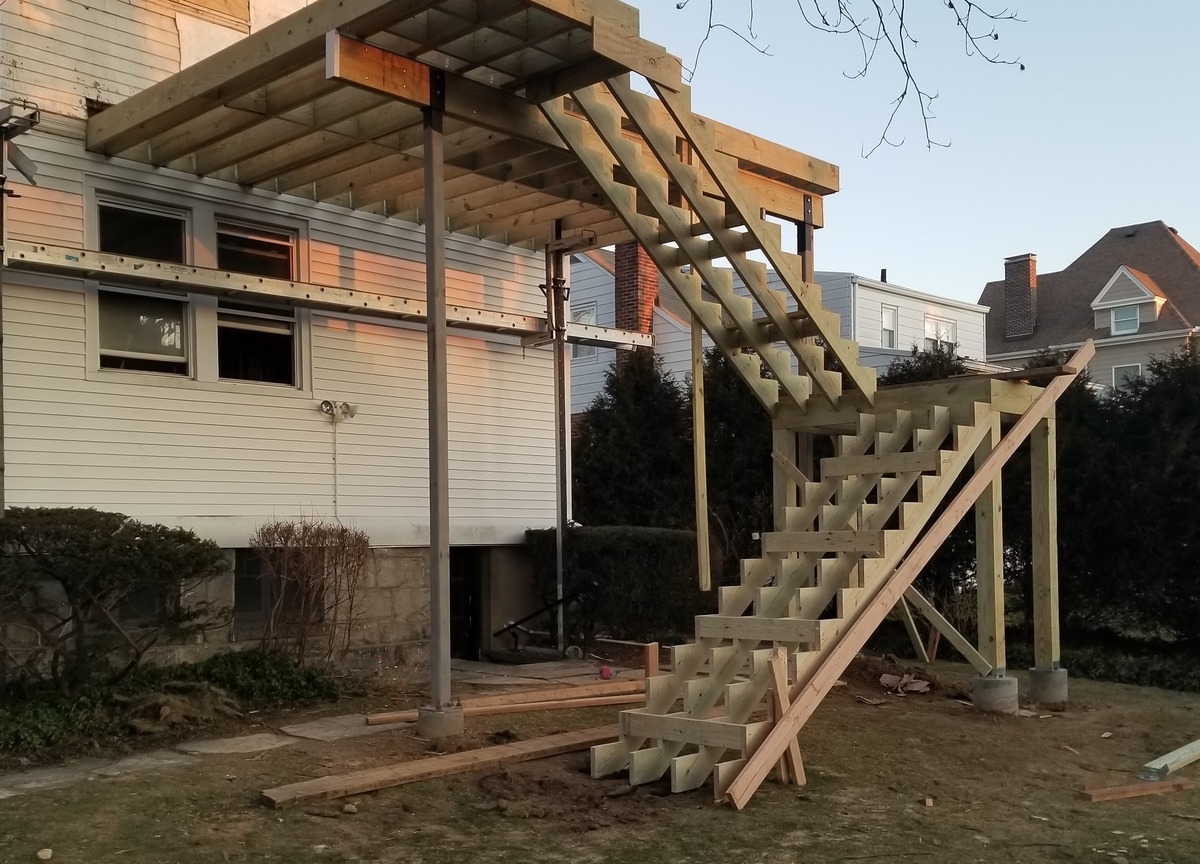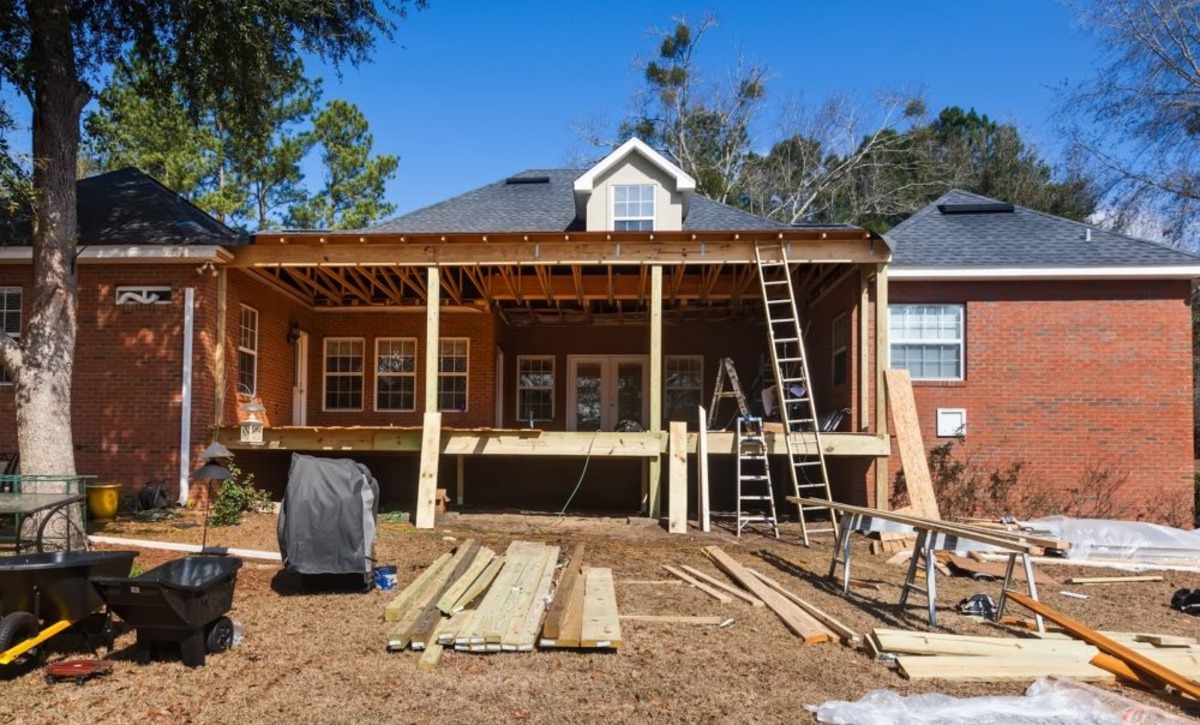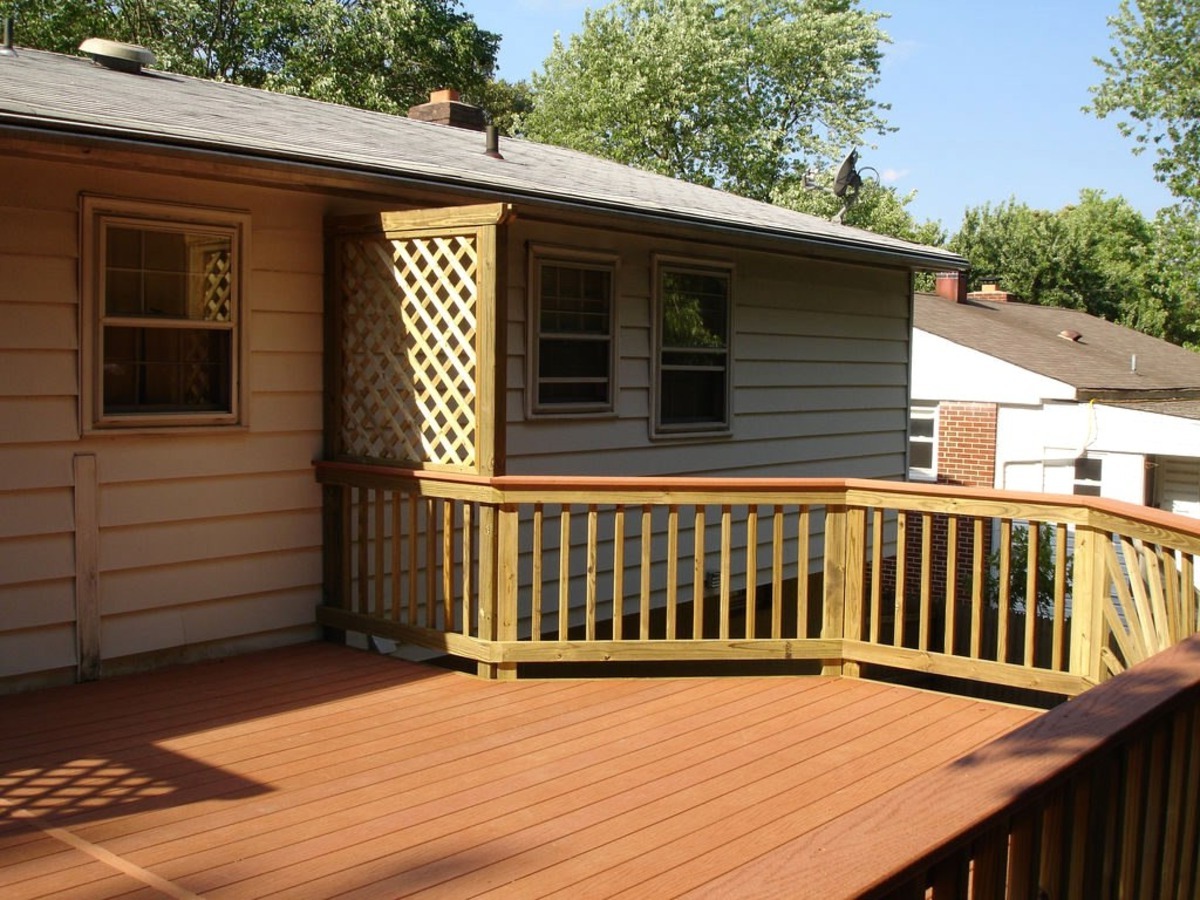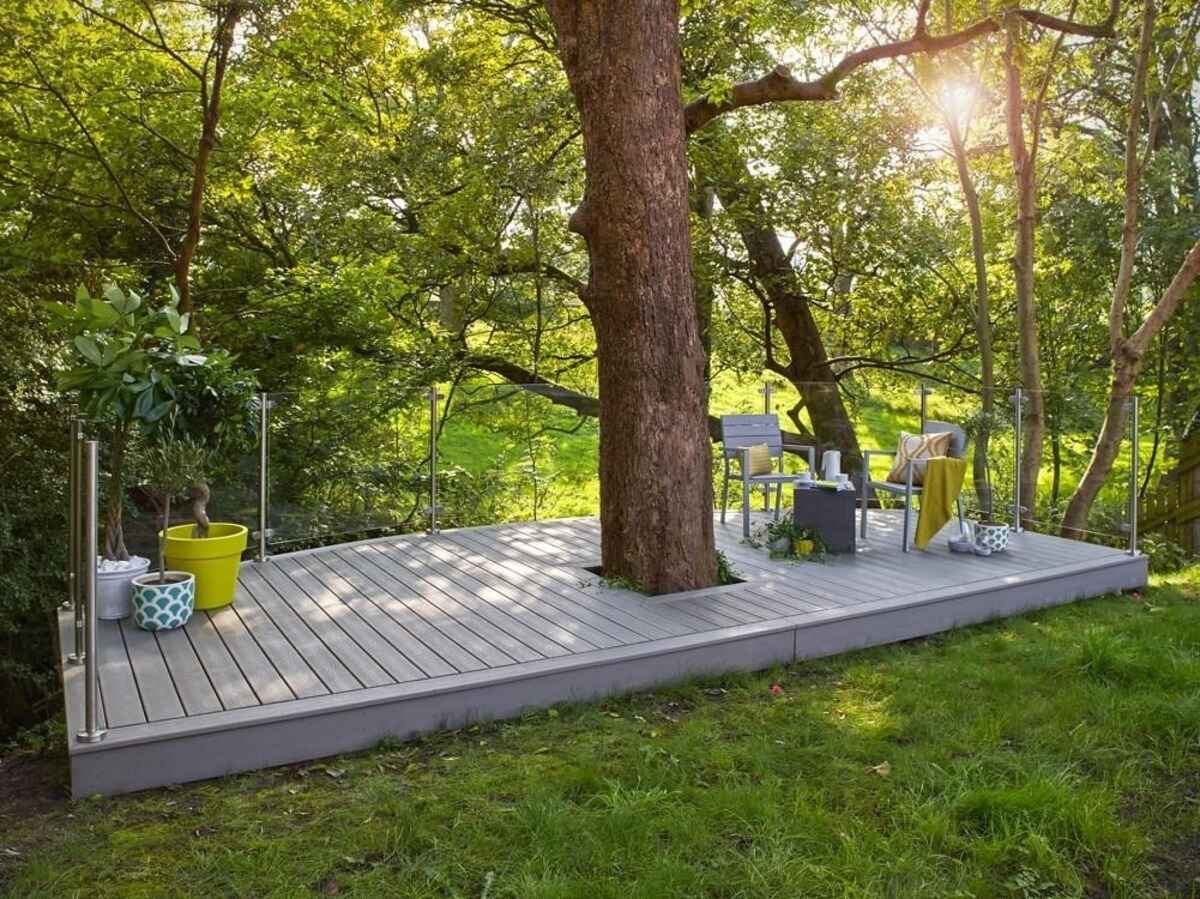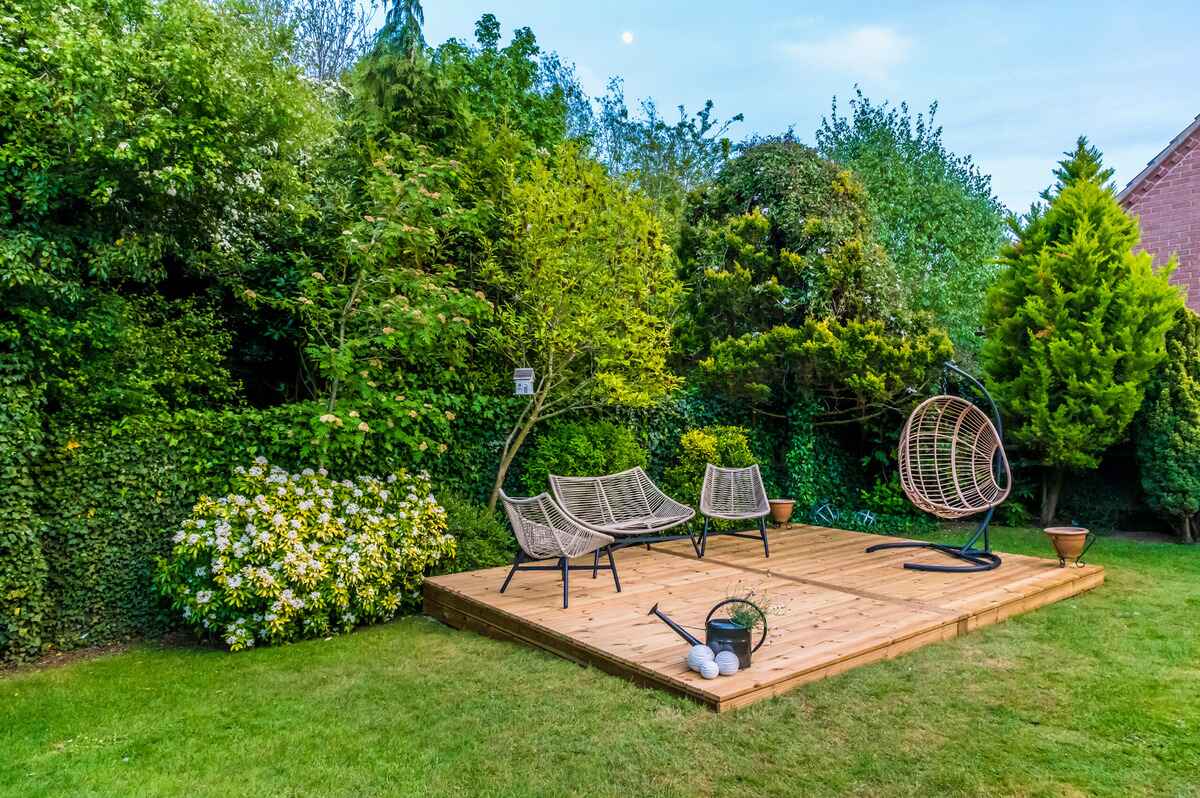Home>Create & Decorate>DIY & Crafts>How To Build A Second Story Deck
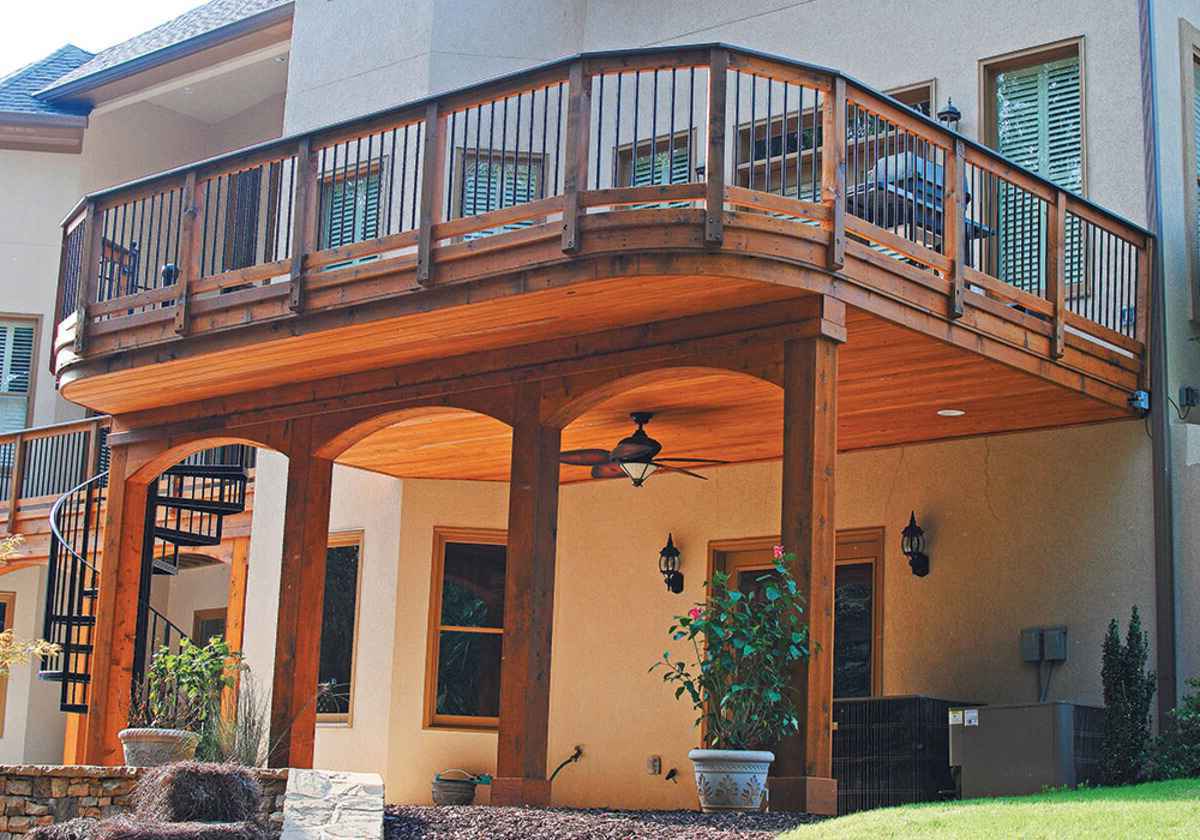

DIY & Crafts
How To Build A Second Story Deck
Published: February 24, 2024

Senior Editor in Create & Decorate, Kathryn combines traditional craftsmanship with contemporary trends. Her background in textile design and commitment to sustainable crafts inspire both content and community.
Learn how to build a second story deck with our step-by-step DIY guide. Create a stunning outdoor space with our expert tips and craft your dream deck today!
(Many of the links in this article redirect to a specific reviewed product. Your purchase of these products through affiliate links helps to generate commission for Twigandthistle.com, at no extra cost. Learn more)
Introduction
Building a second-story deck is an exciting project that can transform the exterior of your home, providing a versatile space for relaxation, entertainment, and enjoying the outdoors. Whether you're envisioning a cozy retreat for morning coffee or a spacious area for hosting gatherings, a well-designed deck can elevate your living experience and add value to your property.
In this comprehensive guide, we will walk you through the essential steps and considerations for constructing a second-story deck. From obtaining the necessary permits and selecting the ideal location to choosing materials, building the support structure, and adding finishing touches, we'll cover everything you need to know to embark on this rewarding DIY endeavor.
By following this guide, you'll gain the knowledge and confidence to plan, design, and build a second-story deck that complements your home's architecture, suits your lifestyle, and meets safety standards. Whether you're a seasoned DIY enthusiast or a first-time builder, this guide will equip you with the insights and tips to create a stunning and functional outdoor space that you can enjoy for years to come.
So, roll up your sleeves, gather your tools, and let's dive into the exciting journey of bringing your dream second-story deck to life!
Read more: How To Build A Two Story Shed
Step 1: Obtain necessary permits and permissions
Before embarking on the construction of a second-story deck, it is crucial to ensure that you have obtained all the required permits and permissions. This step is essential to comply with local building codes, zoning regulations, and safety standards. Failing to secure the necessary approvals can result in costly fines, delays, or even the need to dismantle the deck.
The first step in this process is to contact your local building department or municipal office to inquire about the specific regulations and permits required for building a second-story deck. Each jurisdiction may have its own set of rules regarding setbacks, height restrictions, structural requirements, and environmental considerations. By familiarizing yourself with these regulations, you can ensure that your deck project aligns with the legal and safety parameters.
Once you have a clear understanding of the regulatory requirements, you can proceed to submit an application for the relevant permits. This typically involves providing detailed plans and specifications for the proposed deck, including its dimensions, structural design, materials to be used, and any additional features such as stairs or railings. It's important to be thorough and accurate in your documentation to facilitate the approval process and avoid potential complications.
In some cases, you may also need to obtain permission from your homeowners' association (HOA) or architectural review board if applicable. These entities may have their own set of guidelines and aesthetic standards that need to be adhered to when adding a structure like a second-story deck to your property. Consulting with the HOA or architectural review board early in the planning stages can help prevent conflicts and ensure that your project meets the necessary criteria.
Once you have obtained all the required permits and permissions, it's important to keep the documentation easily accessible throughout the construction process. This ensures that you can readily provide proof of compliance if requested by inspectors or authorities. By diligently completing this initial step, you can lay a solid foundation for the subsequent phases of building your second-story deck, knowing that you are proceeding in accordance with legal and regulatory requirements.
Step 2: Choose the right location for your deck
Selecting the optimal location for your second-story deck is a pivotal decision that significantly influences its functionality, aesthetics, and overall enjoyment. The chosen location should seamlessly integrate with your home's architecture, offer desirable views, and provide a comfortable outdoor living space. Here's a detailed exploration of the key considerations when choosing the right location for your deck:
Assess the Surroundings
Begin by surveying the exterior of your home and evaluating the available space for the deck. Consider the orientation of the sun throughout the day, prevailing wind patterns, and existing landscaping features. Assessing these factors can help you determine the most suitable placement for your deck to maximize sunlight exposure, minimize wind impact, and capitalize on scenic vistas.
Accessibility and Traffic Flow
Evaluate how the deck will connect with the interior of your home and the surrounding outdoor areas. Ensure that the chosen location allows for smooth traffic flow and convenient access from the main living areas. Additionally, consider how the deck will integrate with existing pathways, entry points, and outdoor amenities to create a cohesive and functional outdoor environment.
Read more: How To Build A Tech Deck
Privacy and Views
Take into account the level of privacy and the views offered by different potential locations for the deck. Depending on your preferences, you may prioritize a secluded and intimate setting or seek to capitalize on expansive views of the surrounding landscape. Balancing privacy with scenic vistas can greatly enhance the ambiance and appeal of your outdoor retreat.
Structural Considerations
Consult with a qualified professional, such as a structural engineer or a builder, to assess the feasibility of constructing a deck in various locations. Factors such as the load-bearing capacity of the existing structure, foundation requirements, and potential impact on the integrity of the home should be carefully evaluated to ensure the safety and stability of the deck.
Regulatory Compliance
Verify that the chosen location complies with local building codes, zoning regulations, and setback requirements. Certain jurisdictions may have specific guidelines regarding the placement of second-story decks in relation to property lines, neighboring structures, and easements. Adhering to these regulations is essential to avoid potential legal issues and ensure a smooth construction process.
By thoughtfully considering these factors and engaging in thorough planning, you can identify the ideal location for your second-story deck. This strategic decision lays the groundwork for a successful and harmonious integration of the deck into your home's outdoor space, setting the stage for a captivating and functional addition to your property.
Step 3: Design the layout and size of your deck
Designing the layout and determining the size of your second-story deck are critical steps that directly impact the functionality, visual appeal, and overall usability of the outdoor space. By carefully considering various factors and incorporating your preferences and lifestyle needs, you can create a well-planned deck that seamlessly integrates with your home and enhances your outdoor living experience.
Read more: How To Build A Deck Railing
Assess Your Lifestyle and Needs
Begin the design process by reflecting on how you envision using the deck. Will it primarily serve as a space for intimate gatherings, outdoor dining, relaxation, or a combination of activities? Understanding your lifestyle and preferences will guide the layout and size considerations, ensuring that the deck fulfills your specific requirements.
Consider Practical Elements
Evaluate practical aspects such as furniture placement, traffic flow, and functional zones within the deck space. If you anticipate hosting gatherings or outdoor meals, allocating sufficient space for seating and dining areas is essential. Additionally, factor in circulation paths, potential locations for amenities like grills or outdoor kitchens, and any desired features such as built-in planters or storage.
Harmonize with Your Home's Architecture
Take cues from the architectural style of your home when designing the deck layout. Aim to create a cohesive and harmonious transition between the indoor and outdoor spaces, maintaining a visual flow that complements the existing structure. Consider elements such as the alignment of doors and windows, rooflines, and exterior materials to ensure a seamless integration.
Embrace Versatility and Flexibility
Design the deck with versatility in mind, allowing for adaptable usage and potential future modifications. Incorporating flexible spaces that can accommodate different activities or furniture arrangements enables the deck to evolve along with your changing needs and preferences. This approach enhances the longevity and relevance of the outdoor space.
Read more: How To Build A Deck
Optimize Views and Orientation
Strategically orient the deck to capitalize on favorable views, natural light, and prevailing breezes. By aligning the layout to maximize scenic vistas or shield against undesirable elements, you can create an inviting and comfortable environment that enhances the overall appeal of the deck.
Balance Size and Proportion
Carefully determine the size of the deck in relation to the available space, ensuring that it harmonizes with the scale of your home and the surrounding landscape. Balancing the proportions of the deck with the architectural elements and outdoor environment contributes to a visually pleasing and well-integrated design.
By methodically addressing these design considerations, you can craft a thoughtfully planned layout and size for your second-story deck. This process sets the stage for a well-conceived and purposeful outdoor space that aligns with your lifestyle, enhances the aesthetics of your home, and offers a welcoming retreat for relaxation and enjoyment.
Step 4: Select the materials for your deck
Choosing the right materials for your second-story deck is a pivotal decision that influences not only the aesthetic appeal but also the durability, maintenance requirements, and overall performance of the structure. By carefully evaluating various material options and considering factors such as climate, budget, and desired aesthetics, you can make informed choices that align with your vision for the deck.
Wood
Wood remains a popular choice for decking due to its natural warmth, versatility, and timeless appeal. Options such as pressure-treated lumber, cedar, redwood, and tropical hardwoods offer varying degrees of durability and resistance to decay and insects. While wood decking exudes a classic charm and can be stained or painted to achieve custom looks, it requires regular maintenance, including sealing, staining, and periodic refinishing to preserve its appearance and structural integrity.
Read more: How To Build Composite Deck
Composite Decking
Composite decking has gained popularity for its low-maintenance attributes and long-term durability. Composed of a blend of wood fibers and recycled plastic, composite decking offers resistance to rot, warping, and insect damage. Additionally, it is available in a wide range of colors and textures, often mimicking the look of natural wood while requiring minimal upkeep. Although the upfront cost of composite decking may be higher than wood, the long-term savings in maintenance and longevity make it an attractive option for many homeowners.
PVC and Vinyl
PVC and vinyl decking materials are prized for their exceptional resistance to moisture, mold, and fading, making them well-suited for humid or coastal environments. These synthetic options offer superior durability and require minimal maintenance, typically needing only occasional cleaning to maintain their appearance. Additionally, PVC and vinyl decking are available in an array of colors and styles, providing flexibility in achieving desired aesthetics.
Aluminum
Aluminum decking presents a modern and sleek alternative to traditional wood or composite materials. Known for its lightweight nature, resistance to rust and corrosion, and low maintenance requirements, aluminum decking is particularly well-suited for contemporary and minimalist design preferences. It offers excellent durability and is often accompanied by innovative features such as concealed fastening systems and integrated drainage channels.
Considerations
When selecting materials for your deck, it's essential to consider factors such as local climate, exposure to sunlight, maintenance preferences, and budget constraints. Additionally, evaluating the environmental impact, sustainability, and recyclability of the chosen materials can align with eco-conscious principles and long-term stewardship of natural resources.
By carefully weighing the attributes and characteristics of various decking materials, you can make an informed decision that aligns with your aesthetic preferences, functional requirements, and long-term satisfaction with your second-story deck. Whether you prioritize the natural warmth of wood, the low-maintenance appeal of composites, or the modern allure of alternative materials, the right choice can set the stage for a stunning and enduring outdoor space.
Read more: How To Build A Pool Deck
Step 5: Build the support structure for your deck
The support structure of a second-story deck is a critical component that provides stability, load-bearing capacity, and structural integrity to the entire outdoor platform. Constructing a robust and well-engineered support system is essential for ensuring the safety, longevity, and performance of the deck. Here's a detailed exploration of the key steps involved in building the support structure for your deck:
Engage a Professional Assessment
Before commencing the construction of the support structure, it is advisable to engage a qualified professional, such as a structural engineer or a licensed contractor, to assess the load-bearing requirements and structural considerations specific to your deck design. This expert evaluation can provide invaluable insights into the necessary dimensions, materials, and construction techniques required to meet safety standards and regulatory compliance.
Select Suitable Materials
Carefully select the materials for the support structure, considering factors such as load-bearing capacity, durability, and resistance to environmental elements. Common options include pressure-treated lumber, steel, or engineered wood products, each offering distinct advantages in terms of strength, longevity, and suitability for the intended design.
Determine the Foundation
Evaluate the foundation requirements based on the soil conditions, local building codes, and the anticipated load of the deck. Depending on the specific circumstances, the foundation may involve concrete footings, helical piers, or other engineered solutions to provide stable and secure support for the deck structure. Ensuring proper foundation construction is essential for preventing settling, shifting, or structural failure over time.
Read more: How To Build Deck Stairs
Frame the Substructure
Construct the substructure framework using the selected materials, following the design specifications and engineering recommendations. This typically involves assembling beams, joists, and support posts to create a sturdy framework that distributes the weight of the deck evenly and accommodates the intended layout and size. Attention to detail in framing is crucial for achieving a level and structurally sound foundation for the decking materials.
Install Necessary Hardware
Incorporate appropriate hardware, such as joist hangers, post anchors, and structural connectors, to reinforce the connections and enhance the overall stability of the support structure. Proper installation of hardware components is essential for securing the various elements of the substructure and mitigating potential issues related to movement, uplift, or lateral forces.
Ensure Compliance and Quality
Throughout the construction process, adhere to the relevant building codes, structural guidelines, and manufacturer's recommendations for the selected materials and hardware. Regular inspections and quality checks can help verify that the support structure is being built in accordance with industry standards and best practices, ensuring a safe and reliable foundation for the deck.
By meticulously executing these steps and prioritizing the structural integrity of the support system, you can lay the groundwork for a resilient and dependable second-story deck. Building a robust support structure not only safeguards the safety of occupants but also sets the stage for the successful installation of decking materials, railing systems, and additional features, bringing your vision of an inviting and functional outdoor space closer to reality.
Step 6: Install the decking and railing
With the support structure in place, the installation of decking and railing marks a significant phase in bringing your second-story deck to fruition. This step involves meticulous attention to detail and precision to ensure the seamless integration of materials that not only enhance the visual appeal but also contribute to the safety and functionality of the outdoor space.
Read more: How to Build a Rooftop Deck
Decking Installation
Begin by selecting the appropriate decking material based on your preferences, maintenance considerations, and aesthetic vision. Whether you opt for traditional wood, low-maintenance composite, or alternative materials, the installation process typically involves securing the boards to the substructure using fasteners or hidden clips. Careful alignment and spacing of the decking boards are essential to achieve a uniform and visually pleasing surface while allowing for proper drainage and ventilation.
As you progress with the installation, take care to address any necessary cutting, notching, or shaping of the decking materials to accommodate architectural features, obstructions, or desired design elements. Attention to detail in these customizations contributes to a polished and tailored appearance that harmonizes with the overall design of the deck.
Railing System Integration
The installation of the railing system plays a dual role in enhancing the safety and aesthetics of the deck. Whether you opt for classic wood balusters, sleek metal railings, or modern glass panels, the integration of the railing system involves securing the components to the deck structure while ensuring compliance with local building codes and safety standards.
Carefully measure and plan the placement of the railing posts, ensuring proper spacing and alignment to create a secure and visually appealing perimeter around the deck. The selection and installation of railing components, including posts, balusters, handrails, and connectors, should prioritize structural integrity and adherence to safety guidelines.
Throughout the decking and railing installation process, meticulous attention to craftsmanship, alignment, and fastening techniques is essential to achieve a professional and enduring result. Regular quality checks and adherence to manufacturer's recommendations contribute to the long-term performance and visual appeal of the deck, setting the stage for a captivating and inviting outdoor space that reflects your vision and attention to detail.
By methodically executing these installation steps, you can bring your second-story deck one step closer to becoming a captivating and functional extension of your home, offering a welcoming retreat for relaxation, entertainment, and enjoyment of the outdoors.
Step 7: Add finishing touches and safety features
As the construction of your second-story deck nears completion, the addition of finishing touches and safety features plays a pivotal role in elevating the functionality, aesthetics, and overall appeal of the outdoor space. This phase encompasses a range of considerations, from enhancing the visual allure of the deck to implementing measures that prioritize the safety and well-being of its occupants.
Enhancing Aesthetics
Incorporate elements that enhance the visual appeal and ambiance of the deck, such as decorative lighting fixtures, outdoor furniture, planters, and accessories. Thoughtfully selected and strategically placed, these elements contribute to the creation of an inviting and personalized outdoor retreat, reflecting your style and preferences.
Read more: How To Build A Curved Deck
Surface Treatments
Apply surface treatments such as stains, sealants, or protective coatings to the decking materials to enhance their durability, weather resistance, and visual allure. These treatments not only safeguard the decking against the elements but also contribute to the preservation of its natural beauty, ensuring long-lasting enjoyment of the outdoor space.
Landscaping Integration
Integrate landscaping elements around the deck, such as potted plants, shrubs, or trellises, to soften the transition between the deck and the surrounding environment. Thoughtful landscaping can create a harmonious and inviting outdoor setting, complementing the deck's design and enhancing its connection to the natural surroundings.
Safety Measures
Install essential safety features, including handrails, balusters, and lighting, to promote a secure and user-friendly environment. Ensuring that the deck meets safety standards and building codes is paramount, and the incorporation of robust railing systems and well-illuminated pathways contributes to the overall safety and usability of the outdoor space.
Personalized Touches
Consider incorporating personalized elements that reflect your individual style and preferences, such as custom-built seating, privacy screens, or decorative accents. These personalized touches infuse the deck with character and charm, creating a unique and inviting space that resonates with your vision for outdoor living.
Read more: How To Build A Small Pool Deck
Regular Maintenance Plan
Develop a maintenance plan that outlines routine care and upkeep tasks to preserve the deck's condition and longevity. Regular cleaning, inspections, and minor repairs can help safeguard the investment in your outdoor space and ensure continued enjoyment for years to come.
By thoughtfully addressing these finishing touches and safety considerations, you can bring your second-story deck to its full potential, creating a captivating, functional, and safe outdoor haven that enriches your lifestyle and enhances the beauty of your home.
Conclusion
As you reach the culmination of the journey to build a second-story deck, it's essential to reflect on the transformative process and the remarkable outcome that awaits. The construction of a second-story deck represents not only a tangible addition to your home but also a testament to your vision, creativity, and dedication to enhancing your living environment.
Throughout the meticulous planning, design considerations, material selections, and construction phases, you have embarked on a rewarding endeavor that goes beyond the physical structure. You have envisioned an outdoor space that harmonizes with your lifestyle, complements the architectural character of your home, and provides a welcoming retreat for relaxation, entertainment, and connection with nature.
The completion of a second-story deck signifies the creation of a versatile and captivating extension of your living space, offering a seamless transition between the indoors and outdoors. It embodies the potential for cherished moments spent with family and friends, the delight of savoring the beauty of the surrounding landscape, and the joy of experiencing the simple pleasures of outdoor living.
As you stand on the threshold of enjoying your newly built deck, it's important to recognize the significance of the journey and the pride in the accomplishment. The attention to detail, the thoughtful integration of design elements, and the adherence to safety standards have culminated in the realization of a space that reflects your unique preferences and enriches the overall appeal of your home.
Looking ahead, the completed second-story deck represents a canvas for creating lasting memories, hosting gatherings, and finding solace in the tranquility of outdoor moments. It embodies the potential for personalization, evolution, and the ongoing pursuit of enhancing your living environment.
In conclusion, the construction of a second-story deck is not merely a construction project; it is a testament to your creativity, craftsmanship, and commitment to creating a space that enhances your lifestyle and enriches the essence of home. As you embark on the journey of enjoying your new outdoor haven, may it be a source of joy, relaxation, and inspiration, reflecting the fulfillment of your vision and the enduring beauty of outdoor living.

